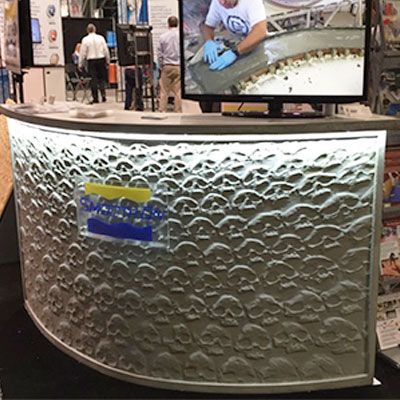
At this year’s US User Group Meeting, David Stubbs from Finishing Touch Frames showed us a picture of an extraordinary desk he’d made using Aspire and his Laguna CNC Router. The desk, for use at a trade show, had a curved front made from molded concrete that was covered in skulls! The process to make this was intriguing so we asked David if he could tell us a bit more about how this unique project was created…
David started by explaining how he initially got involved:
I have a friend, Eric Pottle, who owns a concrete counter top company called Concrete Interiors. The manufacturer of the concrete they use wanted someone to make a desk for a Concrete Trade Show that they attend in Las Vegas. They didn’t want just any desk though; they wanted the face of the desk to be curved and also covered in skulls! After discussing it with my friend I thought this was something we could get involved with.
The initial stage was to model the skull shapes in the software, David told us what the process was for this:
We first started by downloading a picture of some skulls into the Aspire software. We then created the models for the skulls and smoothed them. Once that was done then we went to work on laying out the toolpaths for the CNC. The model was toolpathed with a 1/8” tapered ball nose tool to get good detail. We decided we did not need to do a rough cut as the material was so soft. Downloading the image, creating the model and toolpaths took us around 2 hours.
Once the toolpaths had been created the next stage was cutting the part on their CNC, David continues:
We cut the 3D image out of a pink foam insulation board which we got from the local home improvement store. This was glued onto a piece of backer-board. As we used a relatively small tool for the size of part, the toolpath ran for around 36 hours!
The final stages were to convert the cut part into something that could be used to bend into the curved shape of the desk and poor the concrete onto. This was done by pouring a rubber material supplied from the concrete manufacturer onto the CNC-cut insulation foam’s surface. This takes about a day to cure and then creates a reusable mold. David continues by explaining how this became the concrete desk front:
After the reusable rubber mold had cured, it was laid into a custom curved jig that would be the shape of the finished product. The concrete mixture was poured onto the rubber mold and left to set. After 24 hours the concrete was removed from the rubber mold, a top with lighting was added. It was now a free standing custom made skull desk!
As you can see from the image (see bottom of page - left) this created a striking display for the trade show booth and also showcased how a number of different technologies and processes can come together to make something unique. Interestingly though this type of thing is not typical of what David is involved in day-to-day but does show the potential to expand into other areas if you utilize CNC technology.
David’s main business focuses on finishing he does also make a number of different CNC based products, offered for sale on the internet. To finish our case-study we asked him to tell us a bit about his history, whether he has any tips for people starting with the software and finally what he’s working on now.
He explained to us that his interest in wood work started when working with his dad who was a carpenter:
My dad was old-school, he did everything by hand. He taught me the basics such as how to make jigs and get the job done with what you had.
David took his initial interest and developed it into a career, he now has over 30 years professional experience, originally painting and staining shutters and later working on custom cabinets. The company was founded in 2001 and they added the CNC at the start of 2012. Initially they bought VCarve Pro with their machine as that was recommended to them by Laguna and then upgraded to Aspire in August 2013 to add more 3D functionality. David explained to us that this has increased the potential for what they can do in the business:
Since using the Vectric software accompanied by the CNC, it has opened up a whole new world for me. Like we did with the skull desk it’s nice to be able to use more of our imagination on projects and help the customer get what they want.
When asked for any tips or recommendations for people who are new to the software and CNC, he suggested:
Really pay attention to the tool path preview, check and double check your work so as not to waste CNC time and material. Watch the Vectric tutorials; they are loaded with lots of great info to help you out. Lastly, make sure you charge enough for time and labor!
To conclude we asked David to tell us what they are currently working on:
I am working on my new front reception desk (see bottom right). I laid this out on Aspire & cut out it out on my CNC, then wrapped it around a curved structure, made from plywood, which was also cut on the CNC. In addition I am always working on picture frames and other wood related items that we can sell on the internet too.
We’d like to offer a big thanks to David for sharing his very interesting product with us, if you wish to view more of David's work or get in contact with him please visit www.finishingtouchframes.com.




Vectric Ltd
Precision House
2 Arden Road
Alcester
B49 6HN
GB115123072
Privacy Policy |
Terms and Conditions